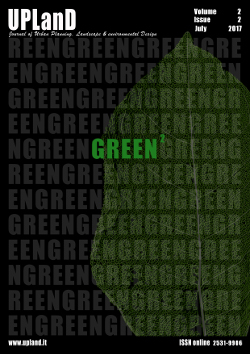Urbanization and Urban design in sustainable development. Case study of the ToLich River regions in Hanoi
Main Article Content
Abstract
In Vietnam, as elsewhere in the world, villages, towns and small cities of noticeable interest (in relation to culture, heritage, history or ecology) on the outskirts of larger cities are suffering serious damage from large-scale rapid urbanization. Development principles that merge historical and cultural heritage with dynamic trade and economy, while preserving an urban identity, with affirmative internal resources and ecological initiatives, guarantee a stable environment towards sustainable urban development.
This research refers to urban design and renovation and landscape design orientated towards sustainable development of small towns along the To Lich River, Hanoi, Vietnam. Focusing on residential concentrations rich in culture, history and traditional trades and crafts, this paper determines and develops the tools to identify characteristic landscapes of urban residential clusters situated along rivers.
The proposal is of an open dynamic sustainable urban trinodal concept that maintains and promotes existing values and strengths for the river landscape. The model consists of Society (Culture-Heritage-History), Economy (Trade-Craft-Agriculture) and Ecology (Environment-Habitation). These shape the identity of the regional landscape (those on each side of the ToLich River) and are also applicable for sustainable developments a long other rivers or territories.
Downloads
Article Details

This work is licensed under a Creative Commons Attribution-NonCommercial-NoDerivatives 4.0 International License.
Authors who publish with this journal agree to the following terms:- Authors retain copyright and grant the journal right of first publication with the work simultaneously licensed under a Creative Commons Attribution License that allows others to share the work with an acknowledgement of the work's authorship and initial publication in this journal.
- Authors are able to enter into separate, additional contractual arrangements for the non-exclusive distribution of the journal's published version of the work (e.g., post it to an institutional repository or publish it in a book), with an acknowledgement of its initial publication in this journal.
- Authors are permitted and encouraged to post their work online (e.g., in institutional repositories or on their website) prior to and during the submission process, as it can lead to productive exchanges, as well as earlier and greater citation of published work (See The Effect of Open Access).
References
Berque, A (dir.), Conan, M, Donadieu, P, Lassu. B, & Roger. A. (1994). Cinq propositions pour une théorie du paysage, Pays/Paysage, Champ Vallon, p.49.
Brunet, R. (2001). Géographie universelle, Mondes nouveaux, Paris, Hachette, (1990). Dans « Le déchiffrement de monde, théorie et pratique de la géographie », Brunet, R. et Dolllfus. O. Lavoisier S.A.S, 402.
Burklin. Turklin, T. & Peterek, M. (2007), Basics Morphologie urbaine, BIRKHÄUSER, 73.
Carley, M. & Kirk, K. (1998). Sustainable by 2020? A Strategic Approach to Urban Regeneration for Britain's Cities. Policy: Bristol.
Clement, P. (2010), Revue : Leçon tirée de Hanoï, Hanoï – Le cercle de métamorphose, Édition scientifique technique.
Collot, M. (1997), Les Enjeux du paysage, par Franceschi. C, Du mot paysage et de ses équivalents, Département de Littérature Française et Littérature comparée de l’Université de Paris X Nanterre, éditions OUSIA, p.6.
Cueco, H. (1995), Approches du concept de paysage, dans « La théorie du paysage en France (1974-1994) », Sous la direction d’Alain Roger, Les classiques de Champ Vallon, 455, p.180.
Dempsey, N. Bramley. G. Power, S. & Brown, C. (2009), The social dimension of sustainable development: Defining urban social sustainability. Sustainable Development: University of Technology: Sydney.
Du Plessis, C. (2000). Cities and sustainability: sustaining our cultural heritage. In Cities and Sustainability: Sustaining Our Cultural Heritage, Conference Proceedings. Brandon, P. Lombardi, P. & Perera, S. (eds.). Sri Lanka: Kandalama.
Giddings, B. Hopwood, B. & O'Brien, G. (2002). Environment, economy and society: fitting them together into sustainable development. Sustainable Development, 10, 187–196.
Hopwood, B. Mellor, M. & O'Brien. G. (2005). Sustainable Development: mapping different approaches. Sustainable Development, 13, 38–52.
http://www.legifrance.gouv.fr/affichCode.do?cidTexte=LEGITEXT000006074075
Jenks, M. & Dempsey, N. (eds). (2005). Future Forms and Design for Sustainable Cities. Oxford, UK: Architectural.
Keivani, R. (2009). A review of the main challenges to urban sustainability. International Journal of Urban Sustainable Development, 1, 15-16
Lynch, K. (1960). The Image of the City. MIT Press: Cambridge, MA, 211, p.46-49.
Malkina-Pykh, I. G. (2002). Integrated assessment models and response function models: pros and cons for sustainable development indices design. Ecological Indicators, 2, 93-108.
Moccia, F.D. & Sgobbo, A. (2013). La polarizzazione metropolitana. L'evoluzione della rete della grande distribuzione verso un sistema policentrico sostenibile. Napoli, IT: Liguori.
Mostafa, S. Badarulzaman, N. & Jaafar, M. (2011). City Development Strategies (CDS) and Sustainable Urbanization in Developing World. Procedia - Social and Behavioral Sciences, 36, 623 – 631. Doi: 10.1016/j.sbspro.2012.03.068
Paulet, J-P. (2002). Les représentations mentales en géographie, Paris, Anthropos, coll. Géographie, 152, p.8.
Saha, D. & Paterson, R. G. (2008). Local Government Efforts to Promote the “Three Es” of Sustainable Development Survey in Medium to Large Cities in the United States. Journal of Planning Education and Research, 28, 21-37.
Sgobbo, A. (2016). Recycling, waste management and urban vegetable gardens. WIT Transactions on Ecology and The Environment, 202, 61-72. doi:10.2495/WM160071
Shen, L-Y. Ochoa, J. J. Shah, M. N, & Zhang, X. (2011), The application of urban sustainability indicators -A comparison between various practices. Habitat International, 35,17-29.
STE 176 –Convention Européenne du paysage, Florence. (2000), Chapitre II – Mesures nationales, Article 5.
USGS EROS Center. (2015), Urban Dynamics Research Program: Analysis of Land Use Change in Urban Environments, USA, http://landcover.usgs.gov/
Wall, Ed. et Waterman, T. (2011), Les essentielles architectures du paysage, Design urbain, Pyramide NTCV, p.17.
Whitehead, M. (2003). (Re)Analyzing the Sustainable City: Nature, Urbanization and the Regulation of Socio-environmental Relations in the UK. Urban Studies, 40, 1183–1206.
Williams, K. Burton, E. & Jenks, M. (eds). (2000), Achieving Sustainable Urban Form. London, UK: Spon.
World Commission on Environment and Development (WCED). (1987), Our Common Future. Oxford, UK: Oxford University Press.
Yokohari, M, Tahara. Shinichi. Kurita, H. & Terada, T. (2011), A Quantitative Assessment of Agricultural Production from Allotment Gardens. Journal of the Japanese Institute of Lanscape Architecture, 74(5), 685-688.

